Looking for the best grass to plant for goats? Our ultimate guide has everything you need to know about choosing the perfect pasture for your animals.
Table of Contents
Introduction
Finding the right grass for your goats can be tricky. Goats need nutritious food to stay healthy and happy. This article will guide you through choosing the best grass for your goats, covering everything from alfalfa to chicory.
Get ready to transform your goat pasture!
Key Takeaways
- Goats need various nutritious grasses for their health, including alfalfa, bahiagrass, and clover. Each type offers specific benefits like high protein or drought resistance.
- The local climate and weather conditions play a big role in determining what kind of grass will grow best in your area. It’s important to pick grass types that can thrive in your local environment to provide goats with year-round nutrition.
- Implementing good pasture management practices, such as soil testing, rotational grazing, and weed control is key to maintaining healthy pastures for goats.
- Mixing different types of grass and implementing companion planting can enhance the nutritional value of goat pastures while promoting sustainable practices.
- Keeping goats’ overall well-being in mind involves more than just selecting the right grass. Regular check-ups, proper nutrition, and disease prevention are crucial for their long-term health.
Why Choosing the Right Grass is Important for Goats
Selecting the right grass for goats directly impacts their health and growth. Goats need a variety of nutritious grasses for optimal development. Each type of grass offers specific nutrients that support different aspects of a goat’s well-being, from digestion to energy levels.
Providing goats with the right mix ensures they get a balanced diet, essential for maintaining good health and preventing diseases.
Different grasses thrive in various climates and conditions, making it crucial to choose varieties that will grow well in your area. This approach supports sustainable pasture management by promoting healthy soil and reducing the need for chemical interventions.
Healthy pastures provide goats with a constant supply of fresh forage, contributing to their overall happiness and productivity.
Best Grass for Goats:
When it comes to finding the best grass for goats, choosing from a variety of options such as alfalfa, bahiagrass, clover, and others can be tailored to the nutritional needs and grazing habits of your goats.
Diving into the complexities of goat nutrition involves exploring suitable grasses like fescue, ryegrass, and timothy that not only enhance their diet but also contribute to overall goat health.
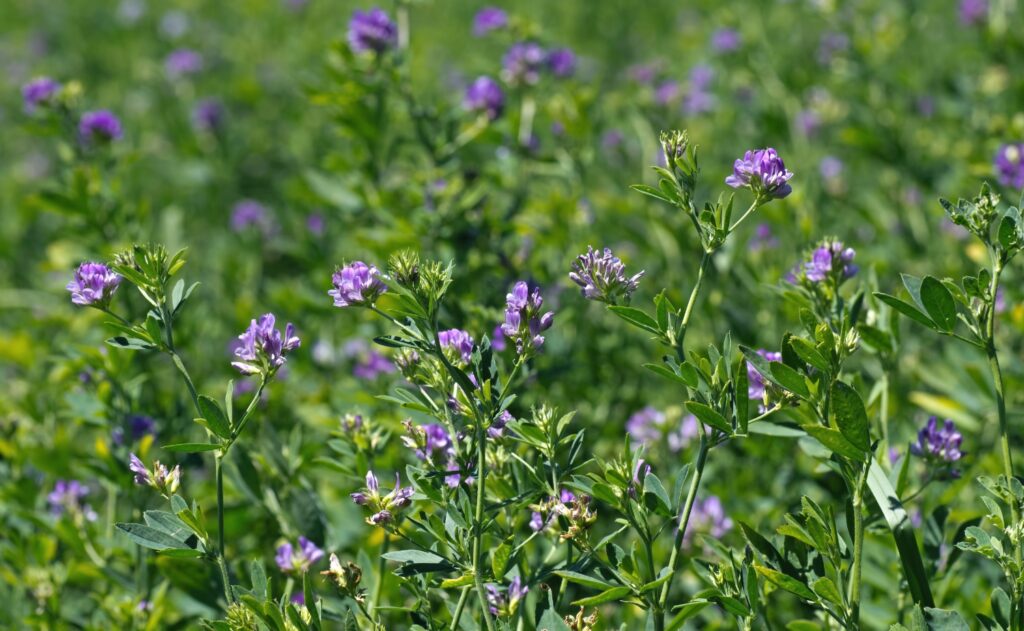
Image Source: Canva
Alfalfa
Alfalfa stands out as a top choice for goat grazing due to its high nutritional value. This plant is packed with proteins, vitamins, and minerals essential for goats’ growth and health.
Farmers favor it because it boosts milk production in dairy goats and supports the rapid growth of young ones. Its deep root system helps withstand drought conditions, making alfalfa reliable even in less-than-ideal weather.
Growing alfalfa for goat grazing also promotes soil health by fixing nitrogen levels and reducing the need for chemical fertilizers. Goats love the taste of alfalfa, which encourages them to graze more actively.
This grass can be planted alone or mixed with other pasture plants to create a diverse and nutritious diet for goats throughout different seasons.
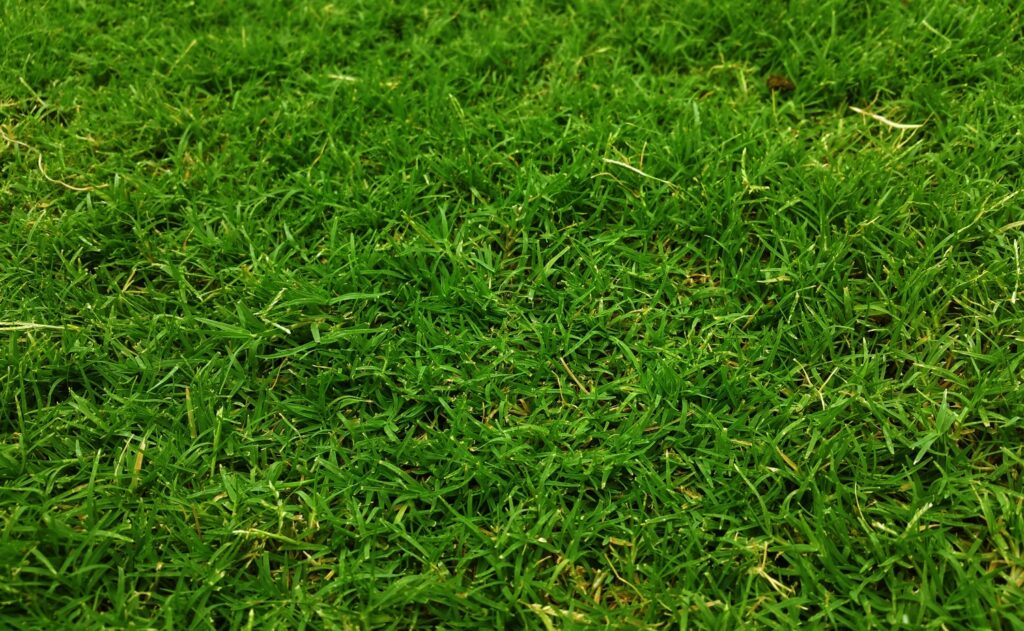
Image Source: Canva
Bahiagrass
Bahiagrass stands out as an excellent choice for goat grazing pasture because of its hardiness and low maintenance. This grass thrives in sandy soil, making it perfect for areas where other grasses might struggle to grow.
Its deep roots help it survive dry spells, ensuring goats have a consistent source of nutrition even in less-than-ideal conditions.
Goats enjoy the taste of Bahiagrass, which is rich in nutrients essential for their health. It quickly recovers from grazing, providing a sustainable option for pasture management.
Farmers find it easy to incorporate into their land due to its adaptability and the minimal care it requires to flourish.
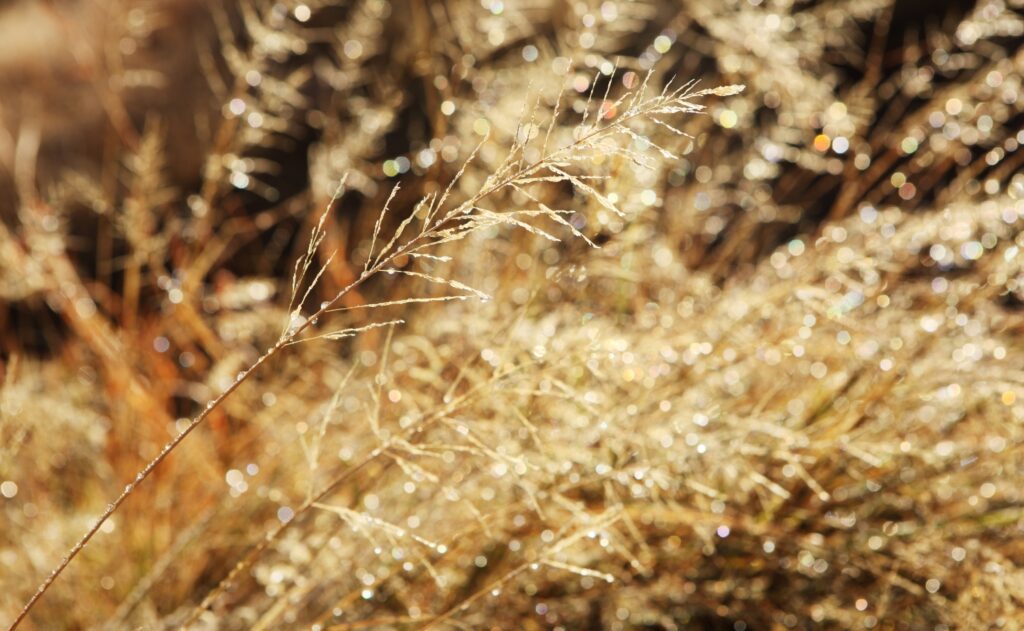
Image Source: Canva
Bromegrass
Bromegrass, known for its high productivity and palatability, is an excellent option for goat pastures. This cool-season grass provides good nutrition and can thrive in a variety of soil types and climates.
Its deep root system makes it drought-tolerant, making it ideal for grazing areas with limited water availability. Bromegrass is also resistant to overgrazing, ensuring sustainable use in goat pastures.
With its high yield potential and adaptability, bromegrass offers a reliable forage solution while promoting healthy grazing habits for goats.

Image Source: Canva
Clover
Clover is an excellent choice for goat pastures due to its high nutritional content and palatability. It’s rich in protein, vitamins, and minerals, making it a valuable addition to a goat’s diet.
Clover also has the benefit of fixing nitrogen in the soil, which can help improve overall pasture health. Goats are known to graze on clover eagerly, and it serves as a great complementary forage alongside other grass varieties.
Its adaptability to various climates makes it a versatile option for goat pasture management.
When considering clover for goats, keep in mind that some varieties may contain compounds that can result in bloat if over-consumed. However, proper management practices such as providing access to roughage and avoiding sudden dietary changes can mitigate this risk.
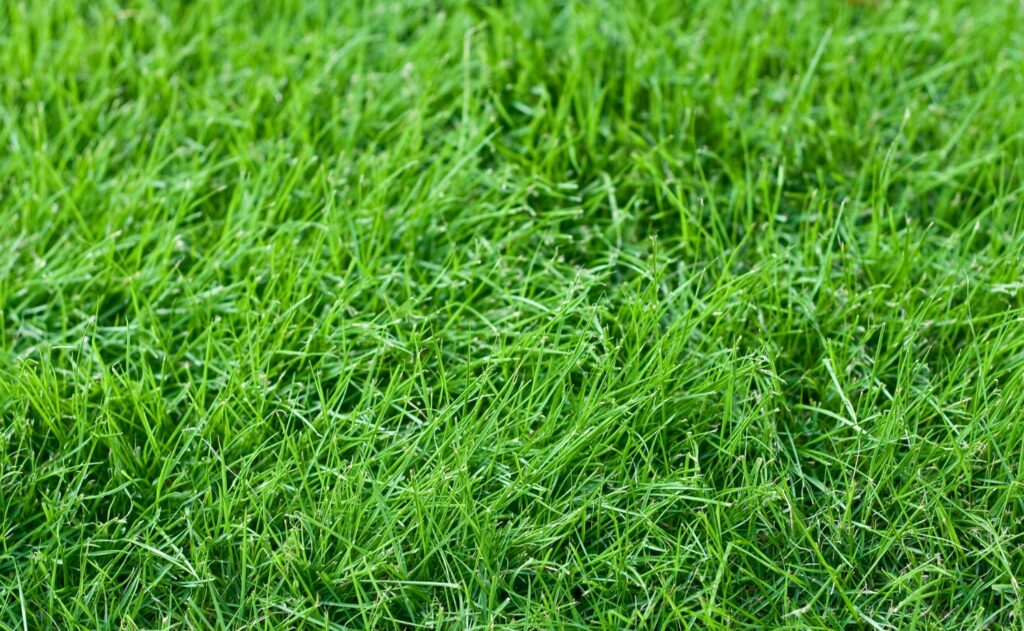
Image Source: Canva
Fescue
Fescue is a hardy grass that can thrive in various climates, making it a versatile choice for goat pastures. Its deep root system helps prevent erosion and makes it drought-resistant, which is beneficial for areas with unpredictable weather patterns.
Fescue also offers good nutrition for goats as it provides an adequate balance of protein and fiber, promoting healthy digestion and overall well-being. It’s adaptable to different soil types, allowing for successful growth in a range of landscapes, from fertile valleys to rocky terrains.
With its ability to withstand heavy grazing pressure, fescue is an excellent addition to any goat pasture.
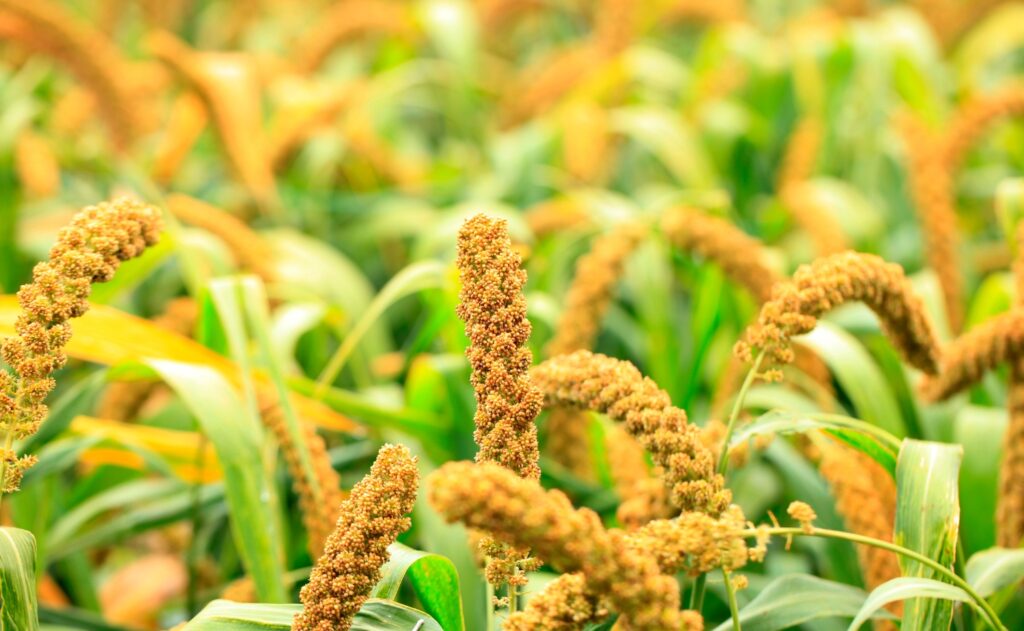
Image Source: Canva
Millet
Millet is a nutritious and versatile grass that can be a valuable addition to goat pastures. It is known for its high yield, especially in dry conditions, making it an excellent choice for areas with limited water resources.
Millet provides essential nutrients for goats and can thrive in various climates, offering flexibility for goat farmers. Its rapid growth also makes it suitable for rotational grazing practices, allowing goats to enjoy fresh feed regularly.
Goat owners should consider the benefits of incorporating millet into their pasture management plans as it offers a reliable source of nutrition and supports sustainable grazing habits.
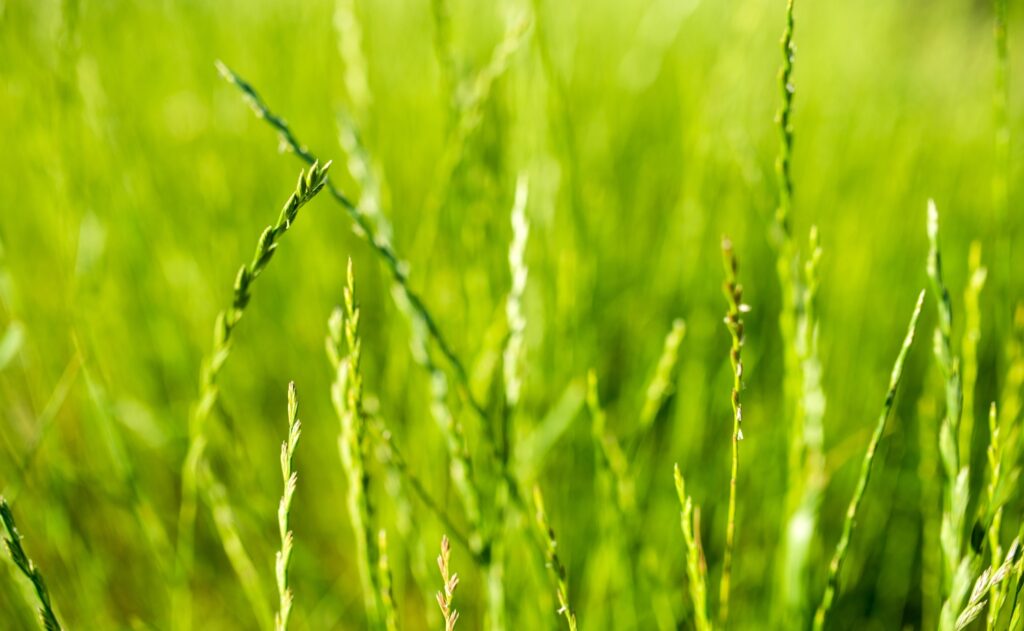
Image Source: Canva
Ryegrass
Ryegrass is a popular choice for goat pastures due to its quick growth and high yield. This cool-season grass provides excellent nutrition for goats, containing high levels of protein and energy.
It is also known for its ability to tolerate heavy grazing and recover quickly, making it a resilient option for goat pasture management. Ryegrass can thrive in various climates and soil types, offering flexibility for different geographic locations.
When considering the best grasses for goats, ryegrass stands out as an optimal choice that meets many nutritional needs while being adaptable to diverse environmental conditions. Its fast growth rate coupled with hardiness makes it a valuable addition to goat grazing options.
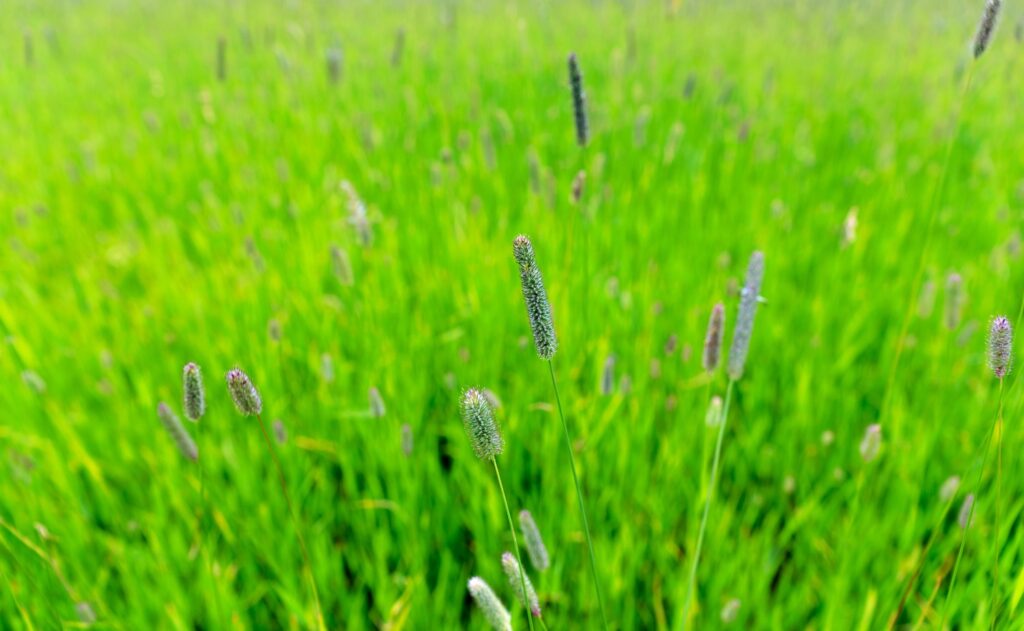
Timothy
Timothy grass is an excellent choice for goat pastures due to its high nutritional value and palatability. This cool-season grass provides a good source of protein, fiber, and energy for goats, making it an ideal grazing option for their overall health.
With proper soil testing and fertilization, Timothy grass can thrive in various climates, providing sustainable grazing options for goat farmers.
Consider integrating Timothy into your goat pastures to enhance the overall nutrition and well-being of your herd. By implementing rotational grazing practices with other compatible grass types, you can ensure a diverse and balanced diet while allowing the Timothy grass to rejuvenate between grazing periods.
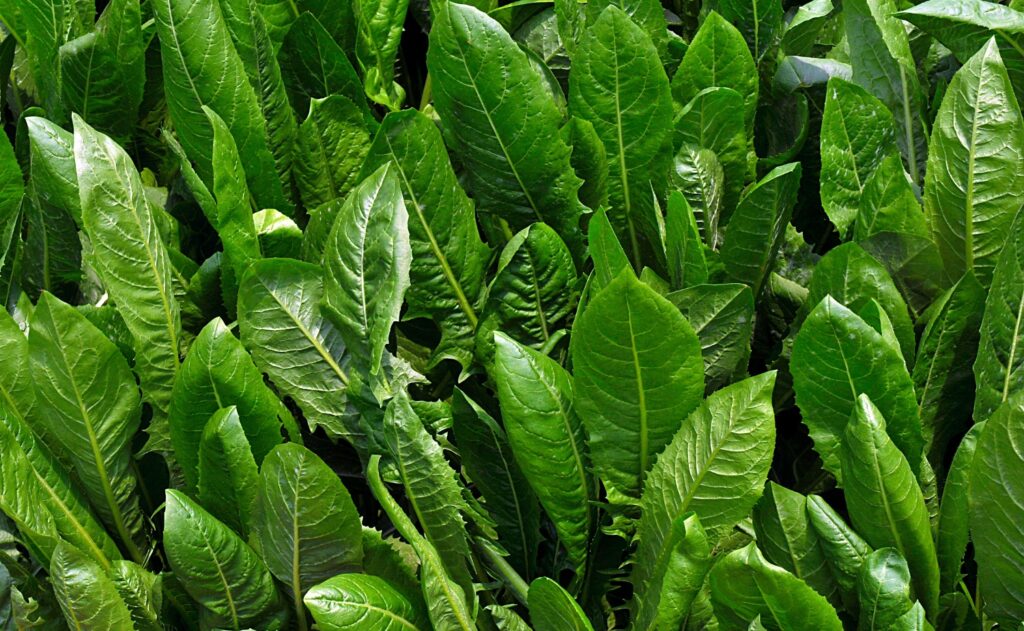
Image Source: Canva
Chicory
Chicory is a highly nutritious forage option for goats, offering a balance of minerals and vitamins essential for their health. This hardy perennial plant boasts deep roots that allow it to access water and nutrients in the soil, making it ideal for dry or drought-prone areas.
Chicory also contains tannins, which can aid in controlling internal parasites in goats. Its high protein content makes it an excellent choice to supplement other grasses in a goat pasture.
Incorporating chicory into your grazing area can provide a valuable addition to the diet of your goats, promoting their overall well-being and productivity on the land.
Factors to Consider when Choosing Grass for Goats:
Consider the nutritional needs, climate and weather, grazing habits, and available land when choosing grass for goats. Read on to discover how these factors impact your goat pasture choices.
Nutritional needs
Goats have specific nutritional needs that must be met through their grazing options. Different grasses offer varying levels of protein, minerals, and vitamins, which are crucial for the overall health and well-being of goats.
When choosing grass for goats, it’s essential to consider their nutritional requirements to ensure they have access to a balanced diet. A variety of grass types such as alfalfa, clover, and timothy can provide the necessary nutrients for goats’ optimal growth and development.
Ensuring that pasture grass meets the nutritional needs of goats is crucial for maintaining their health. Goats require a well-rounded diet with adequate levels of protein, fiber, and essential minerals from the grass they graze on.
Climate and weather
Climate and weather play a crucial role in determining the success of goat pastures. The type of grass that will thrive for your goats is heavily influenced by the local climate, including temperature, rainfall patterns, and seasonal changes.
It’s essential to choose grass varieties that are well-suited to the specific climate and weather conditions of your region. By considering these factors, you can ensure that your goats have access to nutritious and suitable pasture year-round.
Understanding the impact of climate and weather on pasture growth is vital for providing optimal grazing options for goats. Adapting grass selection to climatic variations allows for sustainable management practices that support the long-term health and well-being of your herd.
Grazing habits
Goats are selective grazers, often preferring broad-leaf plants over grass. They tend to graze closer to the ground and may browse on shrubs and trees if given the opportunity. Goats also have a tendency to be more explorative in their grazing patterns, which can lead them to consume a wider variety of plant species compared to other livestock.
Understanding the grazing habits of goats is crucial when selecting pasture grass for optimal nutrition and health. By considering these habits alongside nutritional needs, climate, and available land, you can ensure that your goat pastures provide an appropriate mix of forage options.
Next heading: “Available land”
Available land
When considering the available land for goat pastures, it’s essential to assess the size and topography of the area. The space should provide ample room for grazing and roaming while being free from potential hazards.
By selecting a suitable area that meets these requirements, you can ensure optimal pasture management for goats while promoting their overall health and well-being.
Additionally, when choosing available land for goat pastures, it’s important to consider factors such as soil quality, water accessibility, and shade availability. These elements play a crucial role in creating an ideal grazing habitat that caters to the nutritional needs of goats.
How to Prepare and Maintain Goat Pastures:
Improper pasture management can have negative effects on goat health. Adequate watering and proper drainage are crucial for maintaining healthy pastures for goats. Soil testing, fertilization, and rotational grazing also play key roles in preparing and maintaining goat pastures.
Proper watering and drainage
Proper watering and drainage are vital for maintaining healthy goat pastures. Adequate water supply ensures that the grass remains lush and nutritious, meeting your goats’ nutritional needs.
It’s important to regularly inspect pastures to ensure proper drainage, preventing waterlogging which can damage the grasses and create an unhealthy environment for grazing goats.
Ensuring proper watering and effective drainage keeps your goat pasture in optimal condition, promoting healthy grazing habits while maximizing the nutritive value of the grasses available.
This not only supports your goats’ health but also contributes to sustainable pasture management practices.
Soil testing and fertilization
Soil testing helps determine the nutrient composition of the soil, ensuring that it meets the specific needs of goat pastures. Through soil testing, you can gauge the pH levels, evaluate the presence of essential nutrients such as nitrogen, phosphorus, and potassium, and identify any deficiencies or imbalances.
This information guides targeted fertilization efforts to optimize pasture growth and nutrition. Regular soil testing and appropriate fertilization contribute to maintaining healthy grazing lands for goats all year round.
Fertilization plays a crucial role in enhancing pasture productivity by replenishing vital nutrients based on the results of soil testing. Applying organic matter like compost and manure can boost soil fertility naturally, while commercial fertilizers address specific nutrient deficiencies revealed through soil tests.
Rotational grazing
Transitioning from soil testing and fertilization to rotational grazing, it is important to understand how managing the movement of goats within pastures can benefit their health and optimize forage growth.
Rotational grazing involves dividing a pasture into smaller sections, or paddocks, and rotating the goats through these areas on a scheduled basis. This practice not only allows vegetation in each paddock to recover but also prevents overgrazing in specific areas.
By moving goats frequently, they have access to fresh forage which supports their nutritional needs while promoting better land management practices that enhance overall pasture health and productivity.
Weed control
To maintain healthy goat pastures, weed control is crucial. Regularly inspect the pasture for unwanted vegetation and manually remove weeds to prevent competition with the desired grass species.
Applying an appropriate herbicide can also help in controlling persistent weeds without harming the grazing areas. Implementing proper weed control measures ensures that goats have access to clean and nutritious forage, promoting their overall health.
Moving on to “Other Considerations for Goat Pastures,” let’s explore additional factors that contribute to creating optimal grazing conditions for goats.
Other Considerations for Goat Pastures:
When establishing goat pastures, it’s important to consider a variety of factors beyond the type of grass. Factors such as mixing different types of grasses, companion planting, and implementing sustainable practices play a crucial role in creating optimal grazing environments for goats.
These additional considerations are essential for enhancing the overall health and well-being of goats on your farm.
Mixing grass types
Mixing different grass types in a goat pasture can help provide a well-rounded diet and maximize grazing potential. It’s essential to consider the varying nutritional content, growth patterns, and palatability of different grass species to meet goats’ diverse dietary needs.
By incorporating a mix of grass types such as Bahiagrass for its drought tolerance, Ryegrass for quick initial growth, and Clover for added protein, goats can benefit from a balanced diet while promoting sustainable pasture management.
This approach allows forage availability throughout the seasons and ensures that goats have access to diverse nutrients essential for their health and vitality. Introducing various grass types into goat pastures also contributes to better soil health and reduces the risk of overgrazing on specific plant species.
Companion planting
Companion planting involves strategically planting different types of vegetation together to enhance the growth and health of goat pastures. This method can improve soil quality, deter pests, attract beneficial insects, and provide a diverse range of nutrients for goats.
For example, intercropping legumes with grasses can help fix nitrogen levels in the soil naturally and increase protein intake for goats. Additionally, pairing certain plants together can also help to repel specific pests that may be harmful to goats while attracting insects that are beneficial for the overall pasture ecosystem.
Implementing companion planting techniques into goat pastures offers a sustainable approach to enhancing the nutritional value and diversity of grazing options for goats.
Sustainable practices
Sustainable practices are essential for maintaining healthy goat pastures and ensuring the long-term well-being of your goats. Implementing sustainable practices involves methods such as rotational grazing, which helps prevent overgrazing and allows grass to replenish naturally.
Additionally, integrating legumes like clover into the pasture not only provides a nutritious mix for the goats but also enriches the soil with nitrogen, reducing the need for chemical fertilizers.
Furthermore, practicing proper weed control through manual removal or natural methods contributes to a more sustainable and eco-friendly pasture management system.
By incorporating these sustainable practices into goat pasture management, you can establish an environment that supports both the health of your goats and the long-term productivity of your pastures.
Best practices for overall goat health
In transitioning from sustainable practices to best practices for overall goat health, attention to the complete well-being of your goats is key. Proper nutrition, regular check-ups, and disease prevention are essential components in ensuring optimal goat health.
Regularly monitoring their diet and providing access to fresh water will help maintain their vitality. Additionally, proactive measures such as vaccination and parasite control are crucial aspects for securing longevity in your herd.
Furthermore, maintaining a clean living environment with adequate shelter from harsh weather conditions promotes good health. Frequent observation of your goats’ behavior and physical condition allows you to identify any potential issues early on.
Conclusion
Choosing the best grass for your goats is crucial for their health and well-being. Consider factors such as nutritional needs, climate, and grazing habits when selecting the right pasture grass.
Implement proper pasture management practices like soil testing, rotational grazing, and weed control to ensure your goat pastures are healthy and sustainable. By following these guidelines, you can provide your goats with the ideal grazing habitat for their specific needs.
FAQs
What are the best types of grass to plant for goats?
Ideal grass species for goats include Bermuda grass, fescue, ryegrass, and clover.
How much space do goats need for grazing?
Goats generally require about 250-400 square feet per goat for grazing, depending on the quality of the pasture.
Can I mix different types of grass for my goat pasture?
Yes, mixing various grass species can provide a diverse and nutritious diet for goats while also improving soil health.
Should I consider any specific factors when choosing grass for goat grazing?
Factors to consider include climate suitability, nutritional value, palatability to goats, and resistance to common pests and diseases.
How can I maintain a healthy pasture for my goats?
Regular mowing, rotational grazing to prevent overgrazing, proper fertilization, and monitoring soil pH levels contribute to maintaining a healthy pasture for goats.